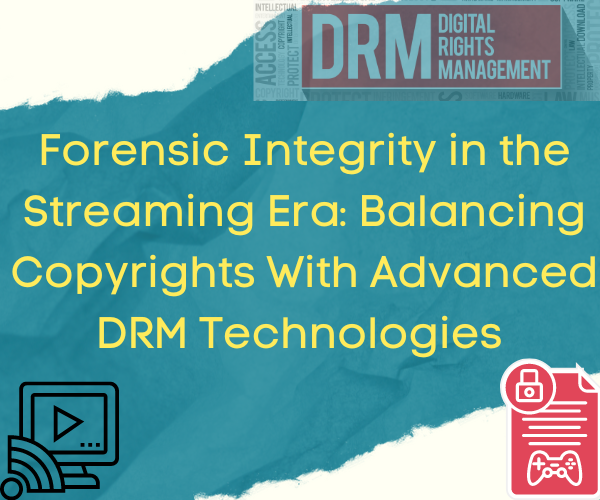
In today’s digital age, the surge in content streaming has dramatically altered how we consume media by offering ease of access like never before. However, this shift has also brought to light intricate challenges in protecting intellectual property rights. A key player in this arena is Digital Rights Management (DRM), a technological solution designed to prevent unauthorized redistribution of digital media and uphold the copyright policies of streaming platforms. This article examines the crucial role of DRM systems, including Google’s Widevine and Apple’s FairPlay, in defending copyright laws. It also explores forensic watermarking, an essential component of DRM, crucial for identifying and curbing copyright violations. This analysis aims to provide a comprehensive understanding of how these technologies defend creators’ rights while raising important questions regarding consumer access and fair use. Understanding this balance is essential in digital streaming, where safeguarding intellectual property must be weighed against the rights and freedoms of users.
Understanding Digital Rights Management (DRM)
Digital Rights Management (DRM) is the digital streaming industry’s technological backbone of intellectual property protection. DRM systems are sophisticated technologies that content providers use to govern how their digital media is used and disseminated. Their primary goal is to prevent unauthorized copying and distribution of copyrighted materials, ensuring artists and distributors retain economic and legal rights. The genesis of DRM can be traced back to the early days of digital content distribution, evolving significantly as internet consumption and digital media technologies advanced. These systems have become crucial in the era of streaming services, where the digital dissemination of media is omnipresent.
The evolution of DRM reflects the changing world of digital media. It began as a reaction to the rampant piracy that accompanied the digitalization of music and movies. It has evolved into a complicated array of systems, each customized to the unique requirements of various content types and distribution channels. Copyright laws are enforced by embedding regulations into digital files that regulate how, where, and for how long the content can be viewed or distributed. This important role of DRM in the streaming ecosystem emphasizes its importance in balancing the rights of content creators while satisfying the demands of an increasingly digital-centric audience.
Major DRM Systems in Streaming Platforms
In the realm of digital streaming, two DRM systems stand out for their widespread adoption and technical prowess: Google’s Widevine, used by Netflix and Apple’s FairPlay, utilized in Apple’s streaming services.
Google Widevine
Essential to Netflix’s content security strategy, Google’s Widevine DRM system excels in flexibility across various devices, which is crucial for Netflix’s diverse audience. It encrypts and controls content access via a multi-tier security framework, with L1 providing top-level security in devices with a Trusted Execution Environment (TEE) and L3 offering essential, software-based protection. This range ensures secure, user-friendly streaming on any device.
Apple’s FairPlay
Conversely, Apple’s FairPlay is designed for its ecosystem, safeguarding iOS, Apple TV, and macOS’s Safari content. It combines encrypted streaming with key delivery, reflecting Apple’s focus on seamless user experience and security. Utilizing HTTP Live Streaming (HLS) ensures a stable viewing experience.
While aiming for copyright protection, these DRM systems showcase Netflix and Apple’s strategies for safeguarding content. Widevine’s versatility supports Netflix’s extensive user base, whereas FairPlay’s integration with Apple’s infrastructure underscores a commitment to a user-focused approach.
DRM and Copyrights
The interaction between Digital Rights Management (DRM) and copyright law plays a crucial role in the arena of digital media streaming. These laws exist to protect creators’ intellectual property, ensuring recognition and financial remuneration. The advent of the internet and digital technologies has made it easier to replicate and share digital content, posing a threat to these rights.
Consequently, DRM has become an indispensable tool in preventing unauthorized access and distribution of digital content. Technologies such as Google’s Widevine and Apple’s FairPlay embed digital restrictions within content, thereby controlling its usage. These constraints could include prohibiting copying or limiting playback to specified devices or regions. Thus, DRM acts as a technological enforcer of copyright laws, embedding these legal safeguards directly into digital media, thereby assisting in preserving creators’ exclusive rights to reproduce, distribute, and display their creative works in the rapidly changing digital media landscape.
Despite its protective nature, DRM has prompted legal issues and criticism. A critical issue of dispute is that it can potentially violate the legal theory of fair use. Fair use permits the unrestricted use of copyrighted material for purposes such as criticism, commentary, news reporting, teaching, scholarship, and research. DRM, critics contend, can overly restrict these permissible applications, resulting in a contradiction between technology enforcement and legal rights.
Furthermore, DRM frequently causes compatibility and access concerns. For example, a DRM-protected movie purchased on one platform may not be watchable on another due to incompatible DRM technologies. This raises concerns about consumer rights and the delicate balance between preserving intellectual property and ensuring acceptable user access.
This constant legal adaptation strives to keep copyright laws relevant and practical in the digital age, protecting creative works while honouring the rights and expectations of consumers. This dynamic interplay represents the endeavour to adapt copyright rules to digital reality, achieving a balance that respects both the rights of authors and the freedom of access of consumers.
DRM’s Role in Content Security and Privacy
Digital Rights Management (DRM) systems have developed into sophisticated forensic instruments beyond their original purpose of copyright protection. Forensic watermarking, a method for locating and identifying pirated content, is essential to this development. The method entails the insertion of distinct, undetectable markings into digital content, which enables the source of unauthorized dissemination to be identified. This kind of technology is essential in the streaming business, where content piracy is a serious concern due to the ease of duplicating and redistributing. Let us say, for instance, that a movie is posted online illegally. In that scenario, the watermark assists in locating the leak’s origin, allowing content producers and law enforcement to take targeted action against the infringers.
Forensic watermarking’s strength is its resilience to manipulation attempts due to its subtlety and strength. By guaranteeing content traceability back to its source, these watermarks serve as a potent deterrence against piracy. Nevertheless, employing DRM as a forensic tool presents ethical and legal issues, especially when balancing user rights, privacy, and intellectual property protection. A nuanced approach to deploying forensic watermarking is required to prevent infringement on authorized material usage and respect privacy requirements. This requires careful control of the technology.
Balancing Act: DRM, Consumer Rights, and Fair Use
Digital rights management (DRM) implementation in streaming services requires carefully balancing copyright enforcement and customer rights. This equilibrium is essential in safeguarding intellectual property while preventing undue restrictions on customers’ rights to fair use and accessibility. The strict restrictions imposed by DRM, intended to prevent piracy and unauthorized use, may interfere with acceptable consumer behaviours like sharing content within the bounds of copyright laws or using content for instructional reasons.
The doctrine of fair use, a legal principle allowing limited use of copyrighted material without permission, often finds itself at odds with DRM systems. These systems can block legally permissible actions under fair use, such as quoting or critiquing copyrighted material for educational or review purposes. This conflict raises critical questions about the flexibility and adaptability of DRM technologies in recognizing and accommodating fair use scenarios.
Customer response to unduly restrictive DRM policies emphasizes how crucial it is to provide DRM solutions that uphold user rights and offer sufficient copyright protection. Finding creative solutions to strike this delicate balance between enforcing copyright laws and protecting consumer freedom and fair use regulations will determine the future of DRM in streaming media. This balance is essential for the digital media environment to remain egalitarian and sustainable.
The Future of DRM in Streaming Services
As the streaming sector expands, Digital Rights Management (DRM) evolves in tandem, adapting to new technologies and shifting user habits. Future DRM enhancements aim to balance content protection with ease of use, preventing complexity from overshadowing the user experience. Embracing cutting-edge technologies like AI and blockchain, DRM could become more sophisticated and secure, managing digital rights more effectively. Standardization and interoperability among DRM systems are also critical for a smooth and accessible digital media framework. These developments in DRM are instrumental for streaming services to effectively safeguard content in the digital era, ensuring a secure, compliant, and user-focused environment. Advancements in DRM technology will be key in shaping how content is distributed and consumed in the streaming realm.
Conclusion
In the ever-changing world of digital streaming, Digital Rights Management (DRM) is essential for protecting intellectual property and guaranteeing customer happiness. The complexity of DRM technologies, such as Apple’s FairPlay and Google’s Widevine, is emphasized in this article, mainly how they are used to combat piracy and enforce copyright laws through forensic watermarking. Future developments in DRM should strike a compromise between content providers’ rights and consumers’ justifiable interests.
Future DRM technologies should place a high priority on user-friendliness and flexibility, including fair-use allowances, in order to create a sustainable digital streaming economy. Integrating cutting-edge technology like blockchain and artificial intelligence promises more sophisticated and secure digital rights management. A smooth media experience also depends on DRM system standardization and interoperability, which improve accessibility while firmly safeguarding material. This balanced approach will enable DRM to remain a vital tool in the digital era, meeting the evolving needs of both content creators and consumers.
*Author – Vansh Tayal
